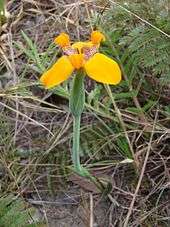Trimezia
| Trimezia | |
|---|---|
| | |
| Trimezia steyermarkii | |
| Scientific classification | |
| Kingdom: | Plantae |
| (unranked): | Angiosperms |
| (unranked): | Monocots |
| Order: | Asparagales |
| Family: | Iridaceae |
| Subfamily: | Iridoideae |
| Tribe: | Trimezieae |
| Genus: | Trimezia Salisbury ex Herbert |
| Type species | |
| Trimezia meridensis Herbert | |
| Synonyms[1] | |
| |


Trimezia is a genus of flowering plants in the family Iridaceae, native to the warmer parts of southern Mexico, Central America, South America, Florida, and the West Indies.[1] The genus name is derived from the Greek words tri, meaning "three", and meze, meaning "greater".[2]
Description
Trimezia typically grow in damp grassland. [3]
The rootstock is variously described as an elongated corm or a rhizome. Plants vary in height from about 7 cm (2.8 in) in the case of T. pusilla to 1.6 m (5.2 ft) in the case of T. spathata subsp. sincorana. Linear to lanceolate leaves grow from the base of the plant. Most species have flowers in some shade of yellow. The six tepals are arranged in two series. The outer tepals (sepals) are larger than the inner ones (petals); both may have brown-purple markings at the base. The stamens have free filaments (i.e. they not fused together or fused to the style). The style is divided into three branches, each of which usually has two lobes.[4]
Distinction from Neomarica
Trimezia is closely related to the genus Neomarica, and species have been transferred between the two genera. According to Chukr & Giulietti (2001), characters of the flowers do not clearly distinguish the genera, whereas vegetative characters do. Some which they consider diagnostic are shown in the following table.[5]
| Characters | Trimezia | Neomarica |
|---|---|---|
| Underground system | always a corm | almost always a rhizome, only a corm in 10% of the species |
| Leaf bases (cataphylls) | arranged in a spiral | arranged in a plane, with the base of one clasping the one above (equitant) |
| Leaves | flattened or circular, not folded | sword-shaped (ensiform), folded lengthwise (conduplicate) |
| Flowering stem (scape) | circular in cross-section (terete), never leaf-like | flattened, always leaf-like |
However, molecular phylogenetic studies have not upheld any of the genera within the tribe Trimezieae; three of the four main clades found all combine species from more than one genus.[6]
Species
As of September 2014, the World Checklist of Selected Plant Families accepts 28 species of Trimezia.[7]
- Trimezia bauensis Ravenna - Santa Catarina
- Trimezia brevicaulis Ravenna - Bahia, Minas Gerais
- Trimezia campanula Lovo & Mello-Silva - Minas Gerais
- Trimezia cathartica (Klatt) Niederl. - Bahia, Minas Gerais, Goiás
- Trimezia chimantensis Steyerm. - Macizo del Chimantá
- Trimezia exillima Ravenna - Minas Gerais
- Trimezia fistulosa R.C.Foster - Minas Gerais
- Trimezia fosteriana Steyerm. - Bolívar in Venezuela
- Trimezia guaricana Ravenna - Guárico
- Trimezia guianensis Ravenna - Guyana
- Trimezia itamarajuensis Ravenna - Bahia
- Trimezia jaguatirica Ravenna - Minas Gerais
- Trimezia juncifolia (Klatt) Benth. & Hook.f. - Brazil
- Trimezia lutea (Klatt) R.C.Foster - Colombia, Venezuela, Brazil
- Trimezia martinicensis (Jacq.) Herb. - Lesser Antilles, Venezuela, Brazil, Bolivia
- Trimezia marumbina Ravenna - Paraná
- Trimezia mogolensis Ravenna - Minas Gerais
- Trimezia organensis Ravenna - Rio de Janeiro
- Trimezia plicatifolia Chukr - Minas Gerais
- Trimezia pusilla Ravenna - Goiás
- Trimezia riopretensis Ravenna - Minas Gerais
- Trimezia sobolifera Ravenna - Florida, Mexico, Venezuela
- Trimezia sooretamensis Ravenna - Espírito Santo
- Trimezia spathata (Klatt) Baker - Brazil, Paraguay, Argentina
- Trimezia steyermarkii R.C.Foster - Mexico, Central America, Colombia, Venezuela
- Trimezia suffusa Ravenna - São Paulo
- Trimezia truncata Ravenna - Minas Gerais
- Trimezia violacea (Klatt) Ravenna - Bahia, Minas Gerais
Some former species which are now regarded as synonyms of those above include:[7]
- Trimezia martii (Baker) R.C.Foster = Trimezia spathata subsp. spathata
- Trimezia meridensis Herb. = Trimezia martinicensis
- Trimezia sincorana Ravenna = Trimezia spathata subsp. sincorana
References
- 1 2 Kew World Checklist of Selected Plant Families
- ↑ Manning, John; Goldblatt, Peter (2008), The Iris Family: Natural History & Classification, Portland, Oregon: Timber Press, pp. 226–29, ISBN 0-88192-897-6
- ↑ Chukr, N.S. & Giulietti, A.M. (2008). Revisão de Trimezia Salisb. ex Herb. (Iridaceae) para o Brasil. Sitientibus Sérrie Ciências Biológicas 8: 15-58.
- ↑ Innes, Clive (1985), The World of Iridaceae, Ashington, UK: Holly Gate International, ISBN 978-0-948236-01-3, pp. 375–379
- ↑ Chukr, Nadia Said & Giulietti, Ana Maria (2001), "New combinations in the genus Neomarica (Iridaceae) and its segregation from Trimezia on the basis of morphological features", Novon, 11 (4): 376–380, doi:10.2307/3393147, retrieved 2012-05-07
- ↑ Lovo, Juliana; Winkworth, Richard C. & Mello-Silva, Renato (2012), "New insights into Trimezieae (Iridaceae) phylogeny: what do molecular data tell us?", Annals of Botany, 110 (3): 689–702, doi:10.1093/aob/mcs127
- 1 2 Search for "Trimezia", World Checklist of Selected Plant Families, Royal Botanic Gardens, Kew, retrieved 2014-09-03
| Wikispecies has information related to: Trimezia |
| Wikimedia Commons has media related to Trimezia. |